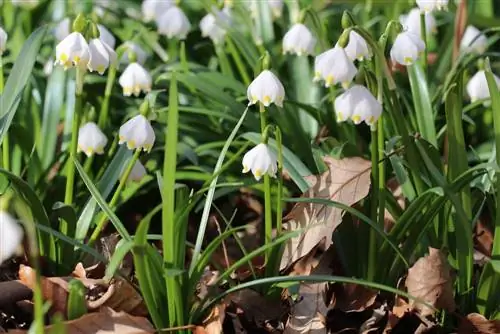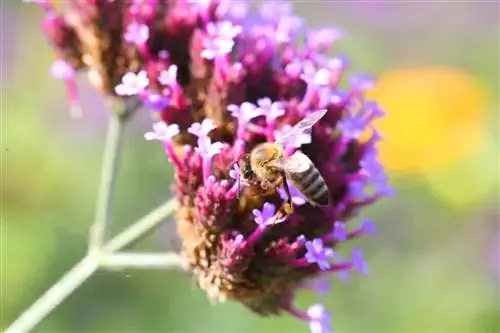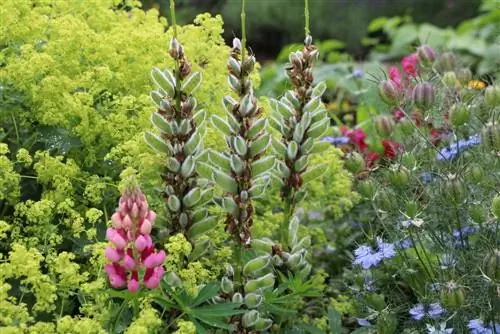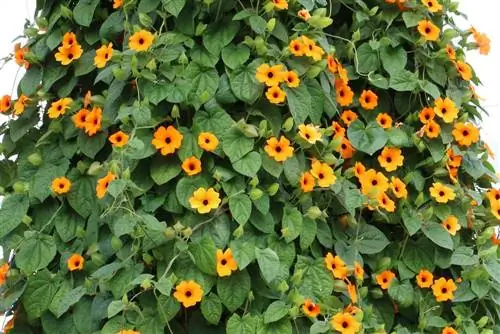- Author admin [email protected].
- Public 2023-12-17 03:39.
- Last modified 2025-01-24 12:45.
Due to its early budding, the Märzenbecher is one of the first signs of spring and is not only pretty to look at, but also an important source of food for insects. In addition, it has always thrilled hobby gardeners with its easy-care character. However, some requirements must still be met so that the Märzenbecher can enchant and beautify the garden for a long time. But you also need to be careful, because the graceful plant with the pretty details is unfortunately tough.
Profile
- Botanical name: Leucojum vernum
- Height: Depending on the variety, approx. 20 to 90 centimeters
- Distribution: Southern Europe, deciduous forests
- Flowering time: February to April
- Appearance: White flowers with jagged edges and green dots
- Propagation: Sowing, breeding onions
- Overwintering: Frost hardy
Location
The Märzenbecher originally grows in forests and on the edge of the forest, where it is moist and protected in the shade. In the garden it needs the same conditions to thrive for a long time. On the one hand, it is advantageous to be close to water, i.e. a garden pond or a watercourse. In addition, protection against wind and sun is advisable, which is why it is advisable to plant directly on walls, denser fences, on and under other plants. It's also nice to let the Märzenbecher grow between stones or brushwood. These decorative details also offer alternative protection.
The big snowdrop shouldn't have to endure blazing sun if possible. Shady or semi-shady locations are better. The Märzenbecher can also beautify dark corners of the garden.
Substrate
The soil for the Märzenbecher must be dense, moist, nutrient-rich and acidic. Substrates that can store water well and are also enriched with rotted leaves or compost are therefore ideal. If there is no dense soil in the garden, you can easily make it yourself by adding clay powder.
As already mentioned, the pH value of the soil also matters. Märzenbecher prefers acidic soils, but does not like neutral and basic substrates. It is therefore advisable to test the pH value in advance and change it accordingly if necessary. If the soil is not acidic, it can be helped with pine needles, bark or cones, oak leaves and bark mulch. Alternatively, rhododendron soil can also be used, which is enriched with compost or leaves and clay.
Tip:
To prevent the substrate from being washed out and then becoming neutral or even alkaline again, planters with drainage holes can be buried. This means that only these need to be filled with the special soil mixture.
Plants
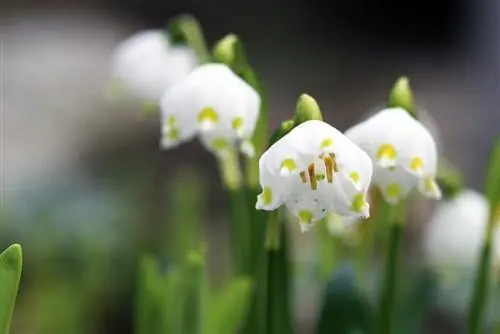
Märzenbecher can be planted in both autumn and spring. The main thing is that they go into the ground on a frost-free day and as quickly as possible after purchase. Depending on the variety, the spring knot flowers can reach a height of between 20 and 90 centimeters, and the growth width varies accordingly. These dimensions should be known before planting the Märzenbecher, because this determines the distance between the plants. Please note:
- The planting depth should be two to three bulb sizes
- In dry weather, water thoroughly to accelerate growth
- Maintain a planting distance of at least half a growing width
In addition, the flower bulbs should be checked carefully before planting. If they are noticeably light, show discoloration, have soft spots or smell musty, they must be disposed of with household waste. Such signs indicate diseases or pests, which is why the damaged plant bulbs should not end up in the compost and certainly not in the bed.
Pouring
Märzenbecher like it to be slightly moist but not wet, but in the right substrate and in the right location they require little care. After growing, they usually take care of themselves. You should only make sure that the soil does not dry out completely. Watering is only necessary during prolonged dry periods, including winter. Watering is done with lime-free water that is as soft as possible. For example, collected rainwater, additive-free pond water or stale tap water. It is important to avoid waterlogging as this will cause the onions to mold quickly.
Fertilize
For the Märzenbecher (spring knot flower), nutrient-rich soil is required, but no additional fertilization is necessary within the first few years. Only when the plants slow down in growth and flowering power should they be supplied with nutrients again. For this purpose, liquid complete fertilizer can be used, which is added directly to the irrigation water. A more natural option is to add compost and rotted leaves to the soil again. Occasional watering with plant manure, from grass clippings or nettles, also serves as gentle fertilization.
In this respect, the Märzenbecher is easy to care for, but care must be taken when fertilizing. Fertilization takes place from December to March at the latest, after which the plant goes into a resting phase. The additional nutrients would disrupt this rhythm if administered later.
Flowering time
The Märzenbecher usually blooms from February to April. Depending on the weather and the previous winter, the flowering period can begin as early as January or as late as the eponymous March.
Propagation
The Märzenbecher is also easy to care for when propagated, as this is possible via seeds, naturalization and breeding bulbs. All variants are simple, but require patience or the right timing.
Propagation by self-sowing
Without any intervention, the Märzenbecher begins to sow itself after the flowering period. To do this, the dried flowers and subsequent fruiting bodies simply have to remain on the plant. So the offcuts have to wait. The fruiting bodies open and spread the seeds with the help of the wind. This means that the location cannot be chosen specifically, but hobby gardeners can look forward to a growing sea of flowers in the coming years.
Propagation by sowing
If you don't want the Märzenbecher to spread uncontrollably in the garden, good timing is required. After the flowering period, the fruiting bodies are left on the plant until they are slightly dry but still completely closed. They are then removed, opened by hand and the seeds are lightly covered with substrate at the desired location. Then you have to wait, because it can take a few years until it blooms. The reason for this is the very short growth phase of the Märzenbecher.
Propagation via bulbs
Propagation via breeding onions is a little more complicated, but much faster. To do this, the Märzen cups are dug up after flowering. Around the main bulbs there are smaller plant bulbs, the so-called breeding bulbs. These can be carefully cut or broken off with a sharp knife and then planted in the desired location. Since there is already sufficient nutrient storage here, there is hardly any need to wait until flowering.
Tip:
Alternatively, a larger collection of bulbs can be divided into two groups and then the entire group can be planted elsewhere.
Blend
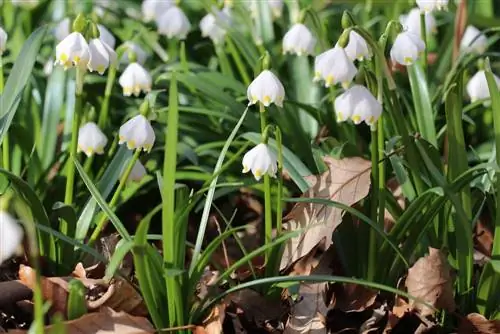
Once the Märzenbecher has faded, the plant initially collects energy and stores it in the bulb. To do this, however, the large snowdrop needs all of its leaves. Therefore, you should wait until the above-ground parts of the plant have completely yellowed before cutting. Only then is everything cut to just above the ground using scissors and skin protection.
Tip:
If it is very moist, a trimming should be made immediately after yellowing. Otherwise, mold and rot could form on the dead parts of the plant and the bulb is in danger.
Wintering
The Märzenbecher is winter hardy and therefore does not need any additional protection even in frosty times. However, care must be taken to ensure that the soil does not dry out even in winter. If necessary, water lightly on frost-free days. This care is essential, especially with regard to early budding, when there is no snow or rain.
Tip:
A layer of bark mulch keeps the soil moist longer and reduces the maintenance effort.
Caution: Toxic
Märzenbecher are poisonous in all parts, which is why mere skin contact is enough to cause severe irritation. If parts of the plant or the juice are ingested orally, a doctor must be consulted immediately. This applies to both people and animals. The Märzenbecher should therefore be avoided in gardens where children play or pets are allowed to let off steam. Alternatively, it should be planted in such a way that accidental contact cannot occur.
In addition, appropriate protection should be worn for all measures, such as cutting or propagation. Gloves are mandatory, skin contact must be avoided and the cutting tools must also be cleaned thoroughly afterwards. This is the only way to ensure that skin irritations or even poisoning do not occur.
Conclusion
The Märzenbecher is an easy-care spring bloomer that can beautify the garden for a long time if cultivated correctly and can even be easily propagated. If you stick to the location and substrate, you don't need a green thumb to see quick and lasting success. In addition, the ants and other insects help the March cups to multiply. Here, the plants use a trick and equip their seeds with an appendage that tastes good to the ants before they drop them on the ground. These carry the appendage into their burrow or eat it on the way there and simply leave the seed lying there. Therefore, after a few years, March cups may grow in places in the garden where they were never planted.
Caring for the Märzenbecher at a glance:
- Location: partially shaded
- Soil: moist and nutrient-rich
- Planting time: September to October
- Planting depth: 5-10 centimeters
- Distance for several bulbs: 10 centimeters
- Propagation: by daughter bulbs or seeds

